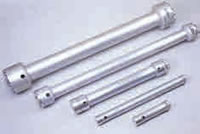| Category: Gas Separation with Membrane Technology > |
Nitrogen Separation Membrane 
H2 Separation Membrane 
Membrane Air Dryer
What our systems - UBE Gas Separation SYSTEM - boil down to is that UBE GAS SEPARATORs are linked with pipes and are skid-mounted for easy installation to separate permeable gases like H2, He and C02 from gas streams. The driving force of the gas separation is the partial pressure difference of each component across the membrane. Accordingly, the pressure of the permeate gas is lower than that of the feed gas. However, the non-permeate pressure is essentially equal to the feed gas pressure.

Dehydration System
Features
- By using UBE's polyimide membrane, it
is possible to supply the feed vapor with the temperature of 120°C (248°C)
and the pressure of 2 barg (28 psig) for example. The partial pressure of
water vapor at the feed side is so high that no extremely high vacuum at the
permeate side is required to secure the necessary driving force for dehydration. - No serious fouling problem occurs on
the membrane surface because the feed is a clean vapor; not a liquid with
contaminants. It brings an advantage of higher durability regarding the membrane
performance. - Simple and compact unit, easy startup
and shutdown operation and easy maintenance can improve the overall process
economics.

CO2 Separation Membrane 
Membrane Separation Process
Membrane Separation performs on the principle of selective gas permeation. When gas mixture is introduced to the membrane, gas component dissolves into membrane material and diffuses through the membrane material. Solubility and diffusivity are different from gas component. Carbon dioxide, water vapor and hydrogen sulfide are easy permeable gas components, while methane, ethane and other hydrocarbons are very slow to permeate. This is why water and sour gas components in the natural gas are removed with the membrane. The driving force of gas separation is partial pressure difference of specific gas component between both sides of membrane.





